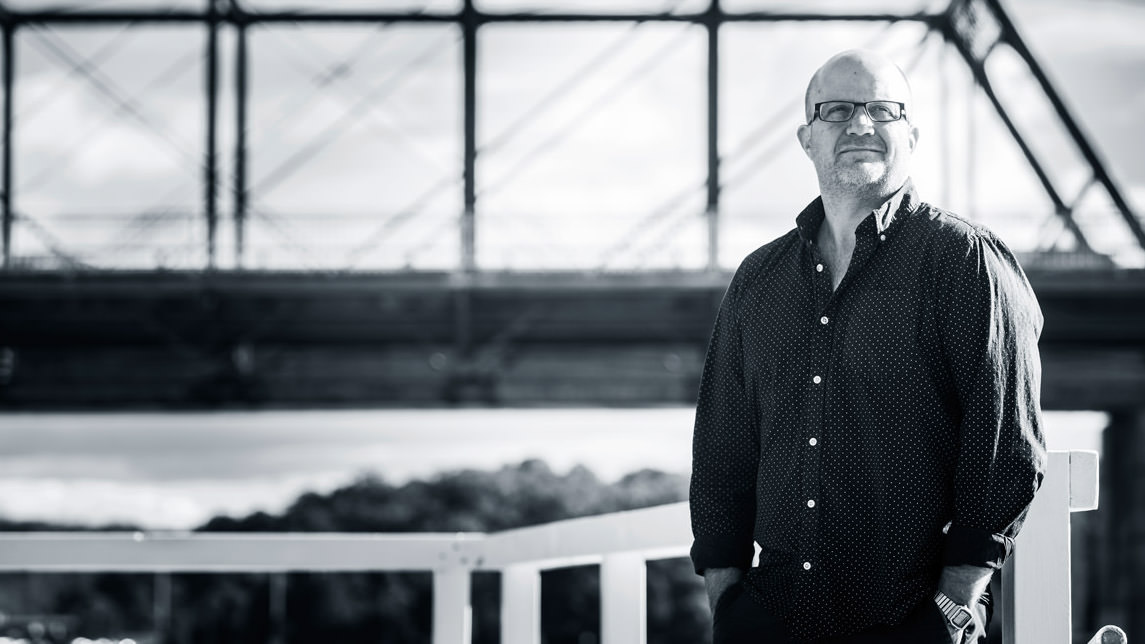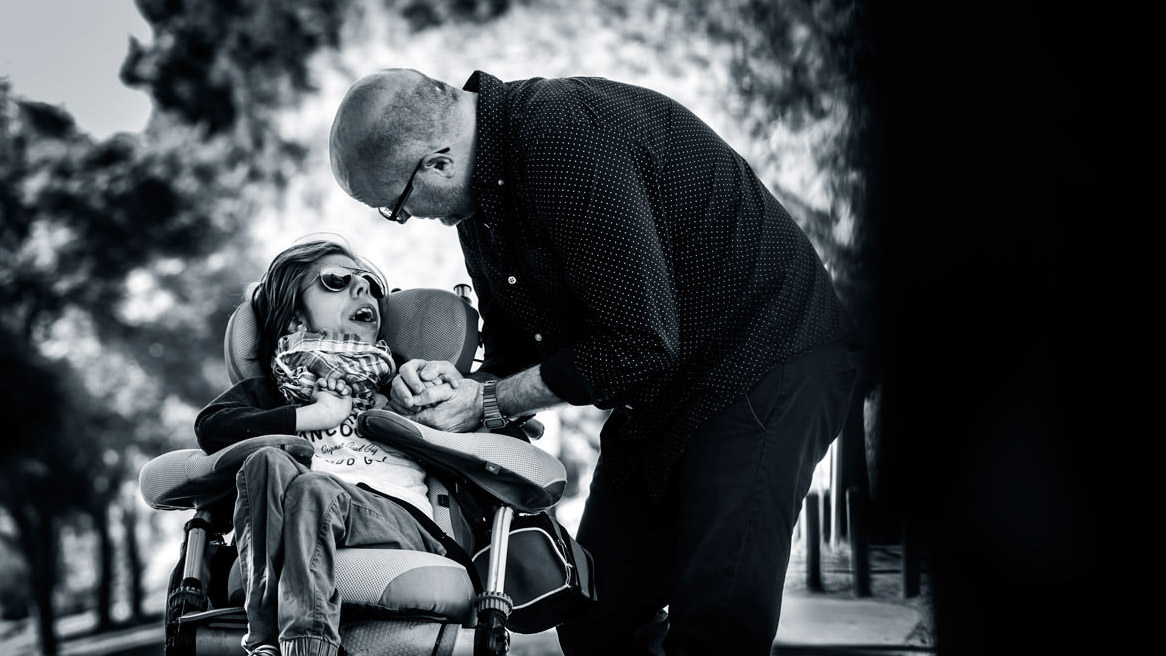Subscribe to The Stand
Want more UOW feature stories delivered to your inbox?
From news director to journalism educator: how a collision with disability changed the course for Shawn Burns.
The arrival of a baby boy in 2003 turned Shawn down a slightly different career path, and made him challenge everything he knew about being a journalist.
"My worlds collided. I was a news journalist, someone who effectively went about my job in a degree of bliss in thinking that I was doing everything that I was taught to do and doing it properly," he says.
Born extremely premature at 26 weeks, a 'microprem', Shawn's son Mac spent the first 16 weeks of his life in a humidicrib and developed cerebral palsy through an acquired brain injury.
"When he arrived life got a little bit more interesting," Shawn muses. "I couldn't continue to work as a news director because I thought I needed to not work 16 hours a day."
After a brief stint as a political adviser, Shawn was looking for ways to get back into journalism and took on a teaching role in UOW's School of Journalism. "I've always enjoyed teaching, even when I was a COS running news rooms, I was always really happy to see interns and junior journalists come through the ranks and do very well."

Shawn Burns is a fierce advocate for giving people with disability a voice in mainstream media. Photo: Paul Jones
The teaching role evolved into research for Shawn, who is currently focusing on disability representation in news media through his PhD and research papers. He credits Mac, now 14, for sparking his passion to give people with disability a voice in mainstream media.
"When someone with a disability appears in your life, you see disability differently and to a large degree you see disability for the first time," he says.
The main focus of Shawn's PhD is ensuring that people with disability or people who identify as disabled are at the heart of the research, and making sure that it's their voice that is being heard in the media.
"If you think about it, the media has the ability to set an agenda," he says. "The media has the capacity to say this story is more important than this story, therefore it can give a hierarchy to issues. It also can influence; if it can't tell people what to think, it can potentially tell people how to think about things."
Associate Professor Mitch Byrne from UOW's School of Psychology says the media has a huge role to play in shaping society's views of disability. "The media certainly influences how the general community understands and reacts to people with different types of disability," he explains.
"Most people don't have a good understanding of disability or what it means to the individual; it's all derived from the media's interpretation of the individual."
Part of the problem with the way that view is shaped, explains Shawn, is the limited way journalists and media outlets tend to portray people with disability.
"Generally you'll see people with disability in the media as being either tragedies or heroes, and there tends to be not a lot of anything else in between."

Shawn Burns credits his son Mac for sparking his research passion. Photo: Paul Jones
The idea that someone is showcased as a hero or inspiration purely because they have a disability is something that comedian, journalist and disability rights activist Stella Young passionately campaigned against.
In a 2014 Ted Talk she discussed her nomination for a community achievement award at the age of 15, a time where she "wasn't doing anything that could be considered an achievement if you took disability out of the equation".
"We have been lied to about disability, we have been told disability is a bad thing, with a capital B, and to live with disability makes you exceptional," she said in the Ted Talk.
Stella coined the term "inspiration porn" to describe the situation where one group of people, in this case disabled people, are objectified for the benefit of another group of people.
"For many people, we're not real people, we are there to inspire," she said.
The issue with the hero/tragedy and inspiration porn approach, says Professor Byrne, is the way the media can influence the way a person with disability sees themselves.
"When a person with disability is presented as a hero, it's saying their achievements are not because of their actions but relative to their level of disability," he says.
"The person who makes those achievements may discount them and think 'if I didn't have a disability this would not be seen as an achievement', which isn't necessarily the case."
"Disability doesn't make you exceptional, but questioning what you know about it does."
- Stella Young, 2014
As Stella Young pointed out in her Ted Talk, "We are more disabled by the society that we live in, than by our bodies and our diagnosis".
Shawn agrees with that sentiment, and says disability only exists because society doesn't do what is required to make sure those with physical and intellectual impairments are included.
"People are disabled by society. Until such time as our society gets its head around the fact that we come all shapes and sizes and abilities, there will continue to be disability. There will continue to be impairment, but we can get rid of disability if society wants to, because it is a construct," he says.
So what can be done to ensure the voices of people with disability are heard, and heard fairly?
In 2010 the ABC received funding to establish Ramp Up, an online space dedicated to the discussion of disability in Australia. Led by Stella Young and Karen Palenzuela, the website published more than 500 pieces of content and provided a space to discuss broad issues relating to disability.
Following cuts to the ABC and SBS in the 2014 Federal Budget, funding for Ramp Up ceased and the website now exists solely as an archive.
In an article written for The Conversation back in 2014, Shawn talked about why the closure of the ABC's Ramp Up website could not have come at a worse time for people with disability.
"Ramp Up was providing space for people with disabilities and disability issues to be presented as a part of the greater fabric of society - with all diversity. The mothballing of Ramp Up is a retrograde step," he wrote at the time.
A similar platform doesn't currently exist among any Australian mainstream media outlets, but that's not stopping Shawn from continuing his campaign for equality and inclusivity.
"My journalism collided with disability, and in this space, in being able to be a journalism educator, I also find myself being someone who is very focused on diversity and inclusion."
- Shawn Burns
"My challenge for myself and my students is that we need to see disability as part of the fabric of society, as part of the fabric of humanity," Shawn says.
"We need people with disability to be included in conversations and they need to be particularly included in conversations around disability."
Australia's peak disability advocacy organisation, People With Disability Australia (PWDA), advocates for 'people-first' language, which means acknowledging the person before the disability.
"How we write and speak about people with disability can have a profound effect on the way they are viewed by the community and themselves. Some words, by their very nature, degrade and diminish people with disability. Other words perpetuate inaccurate stereotypes," the PWDA website states.
Professor Byrne agrees that inclusiveness is key in ensuring the wellbeing of the person being spoken or written about.
"Inclusive language is generally accepted now as the best approach to all people, but particularly for people with disability to as much as possible include them in the patterns of daily life," he says.
"By describing characteristics that describe not who they are, but the disability they carry, it's further differentiating that person from people without disability, which can have a detrimental effect on the person.
"We have to be conscious of the language we use and the way we portray people. Journalists in particular need to focus their stories and their reports on the basis of equity and inclusivity."
"The difference between the almost right word and the right word is really a large matter—it's the difference between the lightning bug and the lightning."
- Mark Twain
That's not to say that a person with disability should not be afforded the opportunity to self-identify if they wish.
"If the person does so in the context of advocacy, then it can not only be helpful to their cause, but also bestow the imprimatur to speak on behalf of people who share the disability," Associate Professor Byrne says.
"Otherwise, just identifying with a disability without context subjects the person to the stereotypes already existing in society. Context is all important for self-identification."
Shawn hopes to use his position as a journalism educator to inform and influence the next generation of journalists.
"My journalism collided with disability, and in this space, in being able to be a journalism educator, I also find myself being someone who is very focused on diversity and inclusion," he says.
"This means making sure my students are aware from the start, from their first subject, that they need to be conscious of the way that they represent diversity, and the way that they are inclusive with their approach and with their language."
In a 2016 essay, Diversity and Journalism Pedagogy: Exploring News Media Representation of Disability, Shawn used his own students as a case study and explored the impact diversity studies have on the post-university lives of journalism students.
The research found that the majority of students, with many now working as journalists, were conscious of the way they represented people with disability in their work and were prepared to challenge work colleagues about their representation of people with disability.
Overall, the students indicated the discussion about media representation of disability, and the potential for news media to influence the way vulnerable groups in society are seen, stayed with them beyond the classroom.
For Shawn, the thought that his lessons may change or shape tomorrow's journalists is what keeps him going.
"Even if 10 of my students each year go out and find themselves in a news room or media office where they question and challenge the way whoever they're working for goes about representing disability, if they might pause and think 'is this actually a true, fair, honest and justified representation?' then that's a good thing," Shawn says.